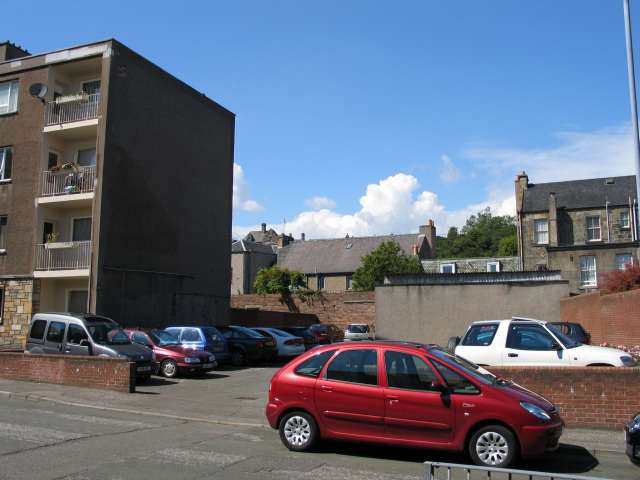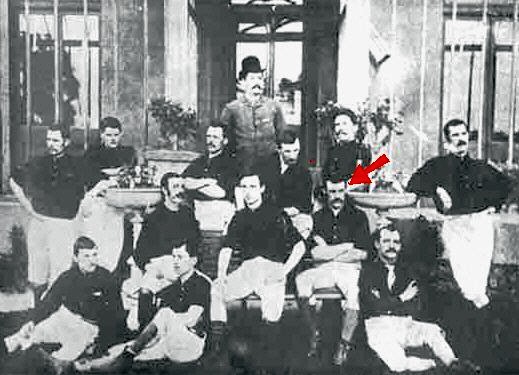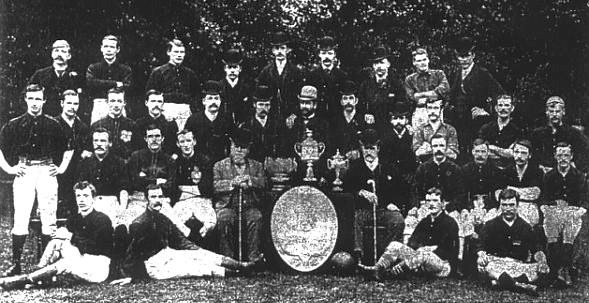|
|
David Danskin
Site navigation - please use menu on left (click here to display it if not visible). If problems, use site map.
|
David Danskin Site navigation - please use menu on left (click here to display it if not visible). If problems, use site map. |
|
|
David Danskin |
|
Links to other pages: |
It is common knowledge that Arsenal Football Club was founded by David Danskin, who until 2001 had always been described as being "from Kirkcaldy". But David Danskin was in fact born in Burntisland in January 1863. The initial source of this welcome news was Richard Wyatt, David's grandson, whose home is near Montreal in Canada. Richard got in touch with us in March 2001 as part of his family history research, and was surprised to learn that the Burntisland connection was apparently unknown in the town.
David's birth registration tells us that he was born at 11.30 p.m. on Friday 9 January 1863 in Back Street (now Somerville Street), Burntisland. The birth was registered by the proud father, also David Danskin.
Unfortunately many of the houses (including the Danskins') weren't numbered in those days. It therefore took a lot of research to identify the precise location of the building where David Danskin was born. The Heritage Trust's Iain Sommerville, John Burnett and Ian Archibald had to delve into old property registers, censuses, valuation rolls and maps.
We discovered that David Danskin senior was a tenant of the Laird family, fishcurers and coopers in Back Street. The old tenement building where David junior was born has long since gone, but it was located on the north side of what is now Somerville Street, on the site currently occupied by the Fife Council car park and part of the Council flats to the west of the car park.
.jpg)
Above
- these old properties were close to the site of the building where
David Danskin was born. They too have been demolished, but they give a
good indication of what the Danskin building might have looked like.
Below -
the approximate site of the building where David Danskin was born.

Returning to the family - David was the second child of David Danskin and Janet Burton, who were married in Kirkcaldy on 17 February 1860. Their first child, Magdalene, was born in Kirkcaldy in 1861, and their third, Christina, in Kirkcaldy in December 1864. So it looks as if their stay in Burntisland at some time between 1861 and 1864 was a short - but fruitful - one.
So why were the family in Burntisland at this time? Following the opening of the Edinburgh and Northern Railway in 1847, Burntisland had become a ferry port and railway terminus of considerable significance. Between 1847 and 1851, a complex of railway engineering workshops had been built, centred on the famous 'Roundhouse'. In 1861, the railway company gave the go-ahead for the building of locomotives at Burntisland - which was already something of a boom town at this time. When in Burntisland, David Danskin senior was an iron turner (lathe operator). It is more than likely that he had taken a job in the railway workshops, perhaps attracted by the high rates of pay and the seemingly good prospects.
In the event, few locomotives were built at the Burntisland depot (although repair and rebuilding continued at a high level). This change may well have prompted the Danskins to move back to Kirkcaldy in 1863 or 1864. Another factor in the decision could well have been the critical shortage of decent accommodation in Burntisland in the early 1860s.

The Roundhouse about 1935. The cleared site is now the overflow car park between the Beacon Centre car park and the railway line.
Following the family's move to Kirkcaldy and the birth there of Christina in 1864, further sisters, Janet and Betsy, were also born in Kirkcaldy - respectively in 1866 and 1868. The family then moved to Leslie, where another three sons were born (one in 1870, who probably died in infancy; Andrew in 1872; and William in 1874).
At the 1881 census, the parents were still in Leslie, at Lothrie Cottage. With them were Janet, Betsy, Andrew and William (who were all still at school), plus grandmother Magdalene Burton, a retired domestic servant. David Danskin senior was then described as a 'Keeper at Water Works'.
David junior had by 1881 left the family home and was living as a lodger with the Henderson family at 318 High Street, Kirkcaldy. He was now eighteen years of age, and employed as an 'Apprentice Engine Fitter at Works'.
In 1885, at the age of 22, David moved from Kirkcaldy to Woolwich in Kent to take up employment at the famous Woolwich Arsenal munitions factory.
The Arsenal Football Club historian, Fred Ollier, told Burntisland Heritage Trust what happened after that:
"In October 1886, after several attempts, David was the main instigator in encouraging a group of football enthusiasts to subscribe towards purchasing a football with a view to forming a football club under the name of Dial Square, the workshop in the factory. Following a meeting on 1 December 1886 at the Royal Oak public house, the club was officially formed and the name changed to Royal Arsenal.
The first fixture was played on 11 December 1886 against Eastern Wanderers at Millwall which Arsenal won by 6-0. David Danskin played and was captain, and the club played 10 matches in all that season. Arsenal continued to develop over the next two seasons, and from the reports, Danskin appeared regularly as a player."

Above
- The 'Royal Arsenal' in 1888,
with David Danskin (arrowed).
(Thanks to Jesper Claesson for the photo and to Fred Ollier for identifying David Danskin.)
Below - Another photo of the 'Royal Arsenal'. Fred Ollier
(to whom we are grateful for the copy of the photo) believes
that David Danskin is the player in the lighter shirt, third from the right in the second row down, and dates the photo as 1889.
However, Soar and Tyler, in their 'Official Illustrated History of
Arsenal', say that David Danskin is seated at the very front, second
from the left, and give the date of the photo as summer 1890. Soar and Tyler add that "The trophies are the Kent
Senior Cup, the Kent Junior Cup, the London Charity Cup (probably the
Shield in fact) and a cup won in a six a side competition at the
Agricultural Hall, Islington. The picture seems to be have been taken
at their new ground, the Invicta, to which they moved that summer."

Fred Ollier continues:
"In 1889-90, however, he [David Danskin] is mentioned less frequently, and after three years, his association with the club appears to end. It has never been clear what happened to him from that point.
Arsenal in 1891 became the first club in the south to adopt professionalism, and joined the Football League in 1893. The only other reference we have to David Danskin was that he was still alive in the 1930's, it being reported that he listened on the radio to Arsenal's 1936 FA Cup Final success from his sickbed."
David Danskin's formal involvement with Arsenal does indeed appear to have ended in the 1892-93 season, although he continued to be active in local football.
Forming a football team was not the only significant thing which David did in 1886. In that year he married his landlady's daughter, Georgina Harradon, whose family had moved to Woolwich from Plymouth. They had three children, but sadly two of them (David and Sarah) died in infancy. The surviving child was William (known as Billy), who was born in 1892.
By 1901, David had left the munitions factory and established a cycle business (both manufacturing and selling) at 60 Herbert Road, Plumstead, in the Borough of Woolwich. At the 1901 census, he described himself as a Mechanical Engineer, and an employer with his own business. The family lived above the shop. One of David's activities was the manufacture of cycle frames, and his Scottish origins are reflected in the trade name he chose to market them under - 'Cushie-doo', the Scots for wood pigeon, with a picture of a pigeon for the logo.
 In 1907, David sold the cycle business and moved
to Coventry, where he began work as an examiner with the fledgling
Standard Motor Company. He was to remain there for the rest of his
working life.
In 1907, David sold the cycle business and moved
to Coventry, where he began work as an examiner with the fledgling
Standard Motor Company. He was to remain there for the rest of his
working life.
Pictured right - David Danskin, probably in his mid to late forties.
1916 was a year of both sadness and joy. In March, David's wife Georgina died of emphysema. In June, son Billy married Mary Jones, and the couple went on to have two sons - Geoffrey in 1918, and Neville in 1924.
In 1918, David married again. His new bride was Rosie Clara Richardson, a colleague at the Standard Motor Company. They had three children - Rosie Hilda (known as Hilda) late in 1918, Ellen Bessie (known as Bess) in 1920, and Richard (known as Dick) in 1926. Sadly, all three died during the course of 2008.
The family were relatively well off in the 1920s. Bess recalled that they had a car, which was uncommon at that time.
When Arsenal won the FA Cup in 1936, David's employers honoured him with a special celebration dinner. Fred Ollier's reference to David listening to the Cup Final commentary from his sickbed is confirmed by Bess. She says that it was around this time that he began to have serious problems with his legs, probably resulting from injuries in his footballing days. Frequent spells in hospital resulted. During one particular stay in Gulson Road Hospital, Coventry, he was told that he had gangrene in one leg and that it should be amputated. His response: "I've got two legs now and if I'm going to die, I'll die with two legs." He survived intact!
But the continuing problems with his legs now effectively forced him to retire. He was given a company pension, which was quite substantial at ten shillings a week, and according to Bess was almost unheard of at the time.
In 1940, the family home in North Street, Coventry, was very badly damaged in the blitz, and they had to evacuate immediately. The next day, when they returned, David's steel trunk, which had been well hidden and which contained all his jerseys, medals, valuables, family photos etc, had been lost.
David was now getting quite old and his health was failing. He needed daily attention at the local hospital in Warwick. Because of this and his lack of mobility, he became an in-patient in 1942 and remained there until his death.
David Danskin died in Warwick on 4 August 1948, aged 85. He is buried in London Road Cemetery in Coventry, beside his first wife, Georgina.
|
David Danskin’s grandson, Montreal-based Richard Wyatt (son of Hilda), was the person who alerted us to the fact that his distinguished ancestor was born in Burntisland. This was in 2001, and, as far as we know, the connection was completely unknown until then. Richard continues the family engineering tradition. With his great grandfather, it was railway locomotives; with his grandfather, bicycles and motor cars; and now with Richard himself, aero engines. It
was therefore a great pleasure to welcome Richard to Burntisland for
two days at the beginning of April 2004. Iain Sommerville had the privilege of showing
him round the town - with a walk along Somerville Street being one of
the highlights, of course! Ian Archibald, Convener of Burntisland
Heritage Trust, gave Richard a presentation on the history of the town. Pictured left - Ian Archibald, Convener of Burntisland Heritage Trust (on the left), shares a joke with Richard when he visited Burntisland Heritage Centre. After his visit, Richard reflected: “It was with some anxiety that after all these years I made the 3,500 mile journey to Burntisland, from my home in St. Bruno, Quebec, Canada. Despite having heard the name of Burntisland, I knew very little about the place, except of course for my grandfather’s connection. For the final few miles after the Forth Road Bridge, I was quite nervous, even emotional. My first impressions of Burntisland were of a town larger than I had expected, with a mixture of architecture that was well laid out and not claustrophobic - and with its own identity. The walking tour of the town was very interesting and showed evidence that this was once a thriving seaport and manufacturing hub. With the right weather conditions, there are some stunning views of the town, surrounding countryside and across the Firth of Forth. It was not too difficult to imagine what Somerville Street must have looked like in the mid to late 1800s, just a pity we couldn't identify the exact house or site where David was living for that brief period. I also visited the Holl reservoir near Leslie, where my family lived from about 1869. The countryside surrounding the site of Lothrie Cottage was just as I imagined - sadly, the old cottage itself, where David’s parents lived, has been demolished, still, that's progress. I was very impressed with the enthusiasm and effort that Ian Archibald and his team have put into the Heritage Trust, it's a lot of work, but will now remain as a permanent record for future generations and hopefully bring curious historians and tourists alike to the region. Having travelled extensively in the U.K. and Europe before I emigrated to Canada and since then in North America, this was truly a memorable adventure that I will always remember. It has special significance when you think that my great grandfather, also named David, was walking these very same streets almost 150 years ago. I hope that this unexpected link with my grandfather to Burntisland will bring additional interest in the town, which in turn creates additional interest in your rich heritage. All the best and you never know, may be back to visit the town with my family in the future.”
David Danskin's youngest brother, William, was born at Lothrie Cottage, Leslie, Fife, in 1874. William had a son, John, who moved to Tyneside and then around 1930 to Yorkshire. John's seven sons all played football with varying degrees of distinction. John's brother Bob played for Leeds United, as did his (John's) grandson Andrew. Andrew emigrated to Australia in 1975, and his son Matthew was born in 1985. Matthew Danskin is a professional footballer of note, and his career to date has included a spell of 18 months with Werder Bremen in Germany.
Arsenal FC, as part of their programme of the 'Arsenalisation' of the Emirates Stadium, have erected eight giant murals on the stadium exterior. These depict 32 of the club's greatest players, and David Danskin takes his place among them. The photo above shows part of the mural featuring David Danskin. Many thanks to Brian Dawes for the information and photo. |
We are very grateful to Richard Wyatt and his family - in particular his late Aunt Bess - for their help with this article. The input of other contributors is also much appreciated.
We also acknowledge our debt to Alan Roper, whose excellent book on the early history of Arsenal is the closest we have to a biography of David Danskin. Alan's book is titled 'The Real Arsenal Story: In the Days of Gog', and was published in 2004. A comprehensive review appears on the Arsenal World website. As of 2018, it appears to be out of print, but second hand copies are available online.
© Iain Sommerville 2001, 2002, 2003, 2004 and 2007
Webpage by Iain Sommerville;
Help
on bookmarking this page.